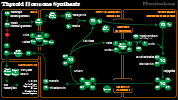II. Physiology
- See Thyroid Anatomy
- Images
III. Indication
- Evaluation of Thyroid Function
- Combined with Thyroid Stimulating Hormone (TSH)
- Together most accurate assessment of Thyroid status
IV. Mechanism: Measurement
- Radioimmunoassay measures bound serum Thyroxine (T4)
- Free Thyroxine (Free T4) measures only active T4
- Not affected by Thyroid Binding Globulin (TBG)
- Free Thyroxine (Free T4) represents 0.03% of total T4
V. Interpretation: Normal
- Thyroxine (T4): 4-12 ug/dl
- Free Thyroxine (Free T4): 0.7 - 1.9 ng/dl
- Pregnancy (Free T4)
- First trimester: 0.8 to 1.2 ng/dl
- Second trimester: 0.6 to 1.0 ng/dl
- Third timester: 0.5 to 0.8 ng/dl
- Abbassi (2010) Obstet Gynecol 114(6): 1326-31 [PubMed]
VI. Causes: Increased Thyroxine (or Free T4)
- Most common
- Grave's Disease
- Toxic Multinodular Goiter
- Toxic adenoma
- Iatrogenic/factitious
- Transient Hyperthyroidism
- Uncommon to Rare
- Hyperthyroid secondary to pituitary disease
- Thyroid Cancer
- Amiodarone
VII. Causes: Decreased Thyroxine or Free T4
- Primary Hypothyroidism
- Hashimoto's Thyroiditis
- Idiopathic Myxedema
- Previous treatment of Hyperthyroidism
- Subacute Thyroiditis
- Prior neck Radiotherapy
- Iodine deficiency or excess
- Congenital
- Medications
- Lithium
- P-Aminosalicylic Acid
- Sulfonamides
- Phenylbutazone
- Amiodarone
- Thiourea
- Secondary Hypothyroidism
- Pituitary dysfunction
- Tertiary Hypothyroidism
- Hypothalamic disease
- Very rare
- Tissue resistance to Thyroid Hormone

